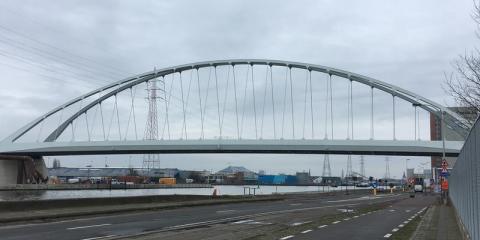The new bridge of Den Azijn must relieve traffic congestion in Antwerp

The new steel arched bridge across the Albert Canal in Deurne – locally known as: ‘bridge of Den Azijn’ – has been officially inaugurated. A total sum of 15 million euro has been invested to improve the bridge. As a result, bigger ships can now sail under it and crossing the bridge has become easier and safer for both public transport, cyclists and pedestrians. “We strengthen alternatives for cars and trucks”, says Flemish Mobility Minister Ben Weyts.
The Flemish government wants to reduce the number of trucks on Flemish roads and therefore invests in inland navigation, which is most definitely an interesting alternative to traffic jams. The most important waterway in Flanders is the Albert Canal, on which over 40 million tonnes are transported on a yearly basis. “This is the equivalent of 2 million trucks”, says Flemish Mobility Minister Ben Weyts. “Without inland navigation on the Albert Canal, we would have had 8000 extra trucks per day on our roads in 2017.”
The Flemish government is currently investing in a larger capacity for the Albert Canal. What this means in practice? By raising all bridges over the canal up to a vertical clearance of at least 9.10 metre, the capacity of the Albert Canal can be increased by no less than +25%. “Ships with 4 container levels will then be able to use this water highway”, says Weyts. “This will make it much more attractive for entrepreneurs and conveyers to exchange the road for the waterway.”
Within the scope of this major investment project, the ‘bridge of den Azijn’ in Deurne was entirely replaced to make way for a brand new arched bridge. The new bridge has a span of 123 m and is 15.60 m wide. The bridge not only crosses the Albert Canal (with a width of 63 m), but also the Vaartkaai (on the side of Merksem), the Merksemsesteenweg (on the side of Deurne) and the towpaths/cycle paths under the bridge.
The new bridge is also perfectly geared to the needs of pedestrians, cyclists and public transport: in both directions, free bus lanes and separate one-way cycle paths and footpaths have been provided for.
“The following investment is already being prepared for”, says Weyts. “After this, we will take on the Theunis bridge.”
The new bridge was officially inaugurated in the presence of minister Weyts, Luk Lemmens, a member of the Executive Council Antwerp, Luc Bungeneers and Tjerk Sekeris, chairmen of the districts of Merksem and Deurne respectively and Chris Danckaert, managing director of De Vlaamse Waterweg nv. “Our waterways must ensure operational reliability and meet the expectations of our customers”, says Danckaert. “We will continue to make the Albert Canal more attractive for companies to invest in the economy and in inland navigation.”
The environment of the Albert Canal in Merksem, Deurne, Schoten and Wijnegem holds the largest industrial estate but one of the Antwerp province. It is also a neighbourhood in which people like to live. This combination generates very diverse traffic flows. The province works together with its many partners, including De Vlaamse Waterweg nv, on a plan for the future: ‘De Kanaalkant’. With this plan, we want to transform the area into a pleasant residential area in which companies are within easy reach. This bridge is one of the actions focussing on a high-quality living, working, traffic and green environment, which are implemented in the field by various public authorities and contribute to the realisation of our vision for the future of the canal environment.
Free-flowing traffic across Antwerp
On top of the investments in bridges over the Albert Canal, several other major works are currently being executed or planned in Antwerp. These works are geared to one another by the various partners to uphold the accessibility of Antwerp.
“It concerns many large-scale works, some of which are executed simultaneously”, says managing director and engineer Chris Danckaerts of De Vlaamse Waterweg’. “A certain degree of inconvenience from all these works cannot be avoided but it can be limited. The waterway authorities are well aware of the impact that works can have on traffic. They make sure that efficient diversions are in place and indicated by clear signposts so that everyone can reach his or her destination smoothly and safely.”
Also during the impending reconstruction of the Theunis bridge, much attention will go to limiting the inconvenience to the maximum extent possible. Except for very short periods, road and tram traffic will always remain possible, be it with a temporary restriction of the number of traffic lanes (2 x 1 traffic lane during the works). To be able to do so, we will build the bridge in phases. First, a new road and tram bridge will be built on the eastern side of the existing bridge. Subsequently, tram and road traffic (2 x 1 traffic lane) will be organised along the new bridges, after which the existing bridges are broken down to make way for a second new road bridge. The completion of this project is scheduled for early 2020.
You can go to www.slimnaarantwerpen.be for all latest information on diversions in and around Antwerp. Real-time information on current works and a smart route planner (which takes into account the major works) show how to travel into or within the city.